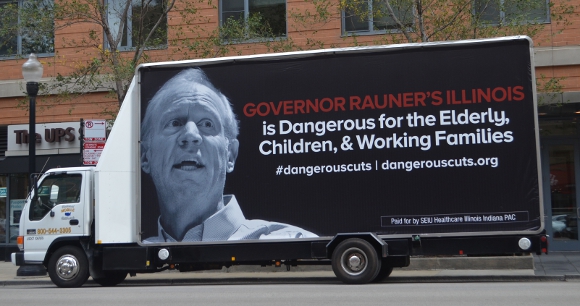ICYMI: New State Journal Register Report Says Gov. Rauner’s Extreme Agenda Is Systematically Destroying Illinois’ Child Care Program
Rauner’s Sustained Attacks on Child Care Assistance Program Results in 48,000 Fewer Children Getting Access to Early Learning as Providers Forced to Close Their Doors, Further Damaging the Economy
FOR IMMEDIATE RELEASE: Wednesday, January 20th, 2016
CHICAGO – The State Journal Register published a must-read story today about how Gov. Bruce Rauner’s sustained attacks on the state’s Child Care Assistance Program (CCAP) is causing significant damage to working families and weakening the state’s entire child care system of providers, teachers, and early learning centers.
Background: On July 1st, 2015 Gov. Rauner unilaterally imposed strict eligibility requirements on low-income families applying for child care which meant that even a parent with a full-time minimum wage job made too much money to get access to child care. Rauner’s extreme rules almost collapsed the entire child care and early learning system.
Then in November 2015, after feeling intense pressure from child care providers and parents and the media, Gov. Rauner cut a deal to relax his previous extreme eligibility requirements. But as the SJR reported today, Rauner’s damage to the Child Care Assistance Program was already done. And the results are that nearly 50,000 fewer children have access to child care, more child care providers have been forced to close their programs or reduce their services and cut staff. And more parents have been forced out of the workforce entirely because they no longer qualify for child care assistance or couldn’t access reliable child care for their kids that allowed them to keep their jobs or go back to school.
Here are the key takeaways from the SJR article below:
The 50 percent of [Federal Poverty Level] requirement was among several new restrictions Rauner used his executive powers to impose July 1, with the aim of saving the state $5.3 million per month statewide.
The program is funded with more than $1 billion each year in state and federal funds.
48,200 fewer [children]
Before July 1, the program accepted children from families with incomes up to 185 percent of the federal poverty level, or $37,165 for a family of three. Fifty percent of FPL meant most families of three with income of more than about $10,000 per year didn’t qualify.
The current limit of 162 percent of FPL institutes an income cap of about $32,550 for a family of three.
The eligibility changes instituted in July didn’t affect children already enrolled, but the new guidelines, criticized as harsh, had a definite impact on participation in the program.
Enrollment dropped to an average of 133,374 children in the period from July through December 2015, compared with the average total of 181,563 children in the program during the same period one year earlier, according to Illinois Department of Human Services spokeswoman Marianne Manko.
That’s a reduction of about 48,200 children, or more than one-fourth of the previous eligibility level.
Even though eligibility guidelines have been mostly restored, there’s still a gap between 162 percent of FPL and 185 percent, and the higher co-payments instituted by Rauner remain, according to Maria Whelan, president and CEO of Chicago-based Illinois Action for Children.
The current income guideline, by itself, keeps 10,000 children out of the program who normally would be admitted under the original income ceiling of 185 percent of FPL, she said.
Another 5,000 children are being denied entry because of a restriction that Rauner opted not to lift, involving children whose parents are in school but not employed, Whelan said.
That still leaves more than 32,000 children who, in theory, could be enrolled in the program but aren’t.
And in terms of the damage to Illinois’ child care providers and workforce, the SJR noted:
The child-care industry in Illinois generates $2.6 billion in annual revenues and employs more than 69,000 people full time, [Maria Whelan] said.
Statistics indicate that thousands of home-based child-care providers have either closed their doors or stopped accepting children whose care is subsidized by the state.
The 24,498 home-based providers who received state subsidies in August had dwindled to 19,975 by October — a drop of more than 4,500 or 18 percent, according to Service Employees International Union’s health-care division in Illinois.
###
